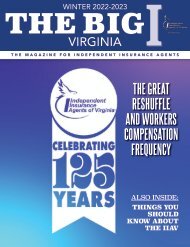Alabama Contractor Summer 2018
You also want an ePaper? Increase the reach of your titles
YUMPU automatically turns print PDFs into web optimized ePapers that Google loves.
THE RISO REPORT<br />
Director of Government Relations, PHCC National<br />
Mark Riso<br />
PHCC WILL WORK WITH CONGRESS<br />
AND THE ADMINISTRATION TO ENSURE<br />
AMERICA’S WATER SYSTEMS ARE SAFE<br />
The DeMany municipalities across the nation confront<br />
critical challenges due to aging water and wastewater<br />
infrastructure projects. According to the American<br />
Society of Civil Engineers, an estimated $150 billion is<br />
currently needed for wastewater infrastructure needs. Many water<br />
systems require immediate repairs, upgrades and replacement;<br />
however, funding is scarce. Part of the overall solution is lowinterest<br />
financing for such projects, which are made available to<br />
municipalities with state revolving funds (SRF).<br />
A SRF is a fund administered by a state for the purpose of<br />
providing low-interest loans for investments in water and<br />
sanitation infrastructure, such as sewage treatment, stormwater<br />
management facilities and<br />
drinking water treatment. A<br />
SRF receives its initial capital<br />
from federal grants and state<br />
contributions and offers bonds<br />
that are guaranteed by the<br />
initial capital. It then “revolves”<br />
through the repayment of<br />
principal and the payment of<br />
interest on outstanding loans.<br />
There are two SRFs: the Clean<br />
Water State Revolving Fund<br />
under the Clean Water Act,<br />
and the Drinking Water State<br />
Revolving Fund under the Safe<br />
Drinking Water Act.<br />
What Is Being Done<br />
About It and Are SRF<br />
Programs Enough?<br />
The recent $1.3 trillion Omnibus spending bill (as passed by<br />
Congress and signed by the President) includes almost $2.9<br />
billion in funding for the Clean Water and Drinking Water<br />
State Revolving Loan funds, which will help state and local<br />
governments fund water treatment and other infrastructure. In<br />
addition, the bill includes new funding in the amount of $63<br />
million for the EPA’s Water Infrastructure Finance and Innovation<br />
Act (WIFIA) program that finances water infrastructure projects.<br />
This is positive – HOWEVER – this is <strong>2018</strong> funding that will<br />
only last until Sept. 30!<br />
What Actions PHCC Needs to Take<br />
WIFIA is a five-year pilot program (starting in 2014) focused<br />
on supporting large-scale projects that may be underserved<br />
by existing state revolving funds. WIFIA is a federal credit<br />
program administered by EPA for eligible water and wastewater<br />
infrastructure projects. The program’s mission is to “accelerate<br />
investment in our nation’s water and wastewater infrastructure<br />
by providing long-term, lowcost<br />
supplemental credit<br />
assistance under customized<br />
terms to creditworthy water and<br />
wastewater projects of national<br />
and regional significance.”<br />
IFIA (set to expire at the end of<br />
<strong>2018</strong>) needs to be reauthorized<br />
and needs to receive increased<br />
federal funding. WIFIA is<br />
currently being considered in<br />
the House and Senate. PHCC<br />
is meeting and working with<br />
the American Water Works<br />
Association, the Water Quality<br />
Association, and Plumbing<br />
Manufacturers International to<br />
reauthorize and increase funding<br />
for WIFIA. PHCC-National<br />
Association is currently working (in conjunction with allied<br />
organizations) to build a campaign for WIFIA reauthorization<br />
and will soon involve PHCC members.<br />
6 <strong>Alabama</strong> <strong>Contractor</strong> • www.alabamaphcc.org • <strong>Summer</strong> <strong>2018</strong>


















